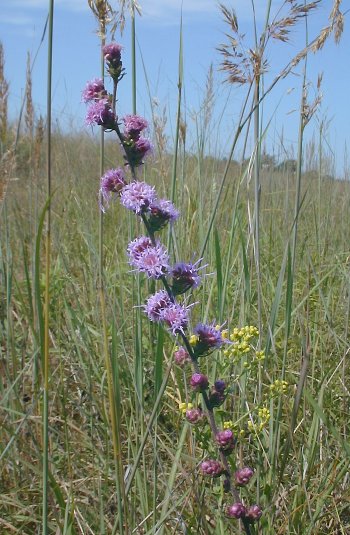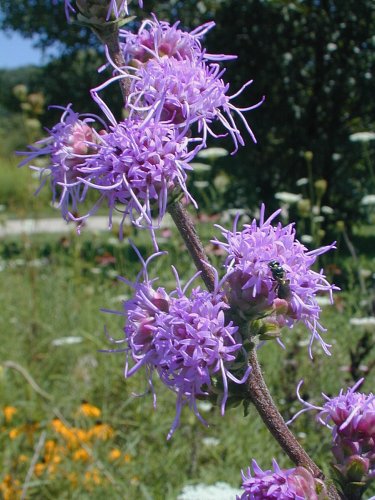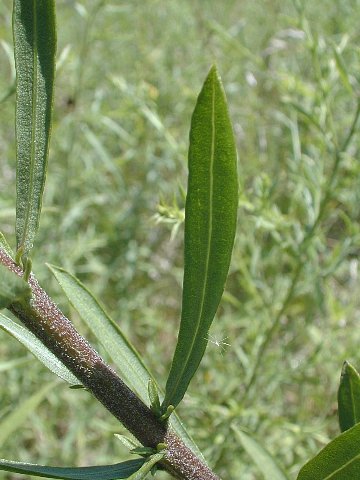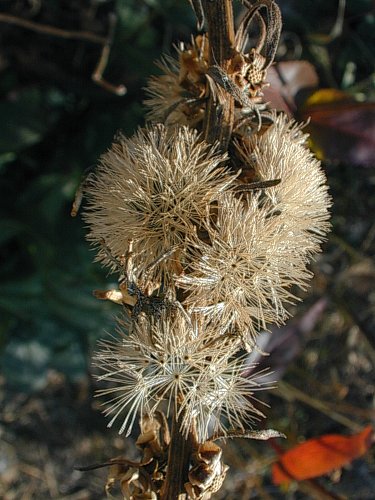Description: This perennial plant is 2-5' and unbranched. The central stem is green or dark red, and it has short stiff hairs. The leaves toward the base are up to 12" long and 1" wide, becoming progessively shorter and narrower as they alternate up the stalk. The leaves are sufficiently crowded together that they appear whorled. They are narrowly lanceolate or linear, dull green or bluish green, and usually slightly pubescent. The margins are smooth or slightly ciliate.

The central stem terminates in an erect spike-like inflorescence with pink or purplish pink composite flowers. This inflorescence is about ½–1½' long, with the composite flowers more or less densely distributed along its length. The individual flowers are crowded together into buttons about 1" across. Each flower has 5 lobes that spread outward from the corolla tube, from which emerges a long divided style that is often curly. There is no floral scent. The blooming period occurs from late summer to early fall and lasts about 3 weeks for individual plants. Like other Liatris spp., the flowers of Rough Blazingstar begin to bloom at the top of the flowering stalk, and gradually bloom downward as the season progresses. The achenes have large tufts of stiff hair that are light greyish brown, which enables them to be distributed several feet by the wind. The root system consists of a woody corm. Occasionally, offsets develop a short distance from the mother plant, creating small colonies.

Cultivation:
The
preference is full sun and mesic to dry conditions. The soil can
contain significant amounts of loam, clay, sand, or rocky material.
However, this plant typically grows in less fertile acidic soil that is
rather rocky or sandy. This plant is easy to grow under well-drained
conditions, but has a tendency to flop over while in flower if it is
spoiled with rich soil or too much moisture. Foliar disease is rarely a
problem, and drought resistant is very good, with only a few lower
leaves withering away.
Range & Habitat:
The native Rough Blazingstar is occasional in central and northern
Illinois, but it is
uncommon or absent in SE Illinois (see Distribution
Map). This wildflower is widely distributed, but rarely forms
large
colonies in native habitats, unlike Liatris pychnostachya
(Prairie Blazingstar). Habitats include mesic to dry black soil
prairies, sand prairies, gravel prairies, hill prairies, bald knobs,
openings in rocky upland forests, sandy Black Oak woodlands, savannas,
limestone glades, dry clay banks above ditches, and open areas along
railroads, particularly where prairie remnants occur.

Faunal Associations: Primarily long-tongued bees, butterflies, skippers, and bee flies visit the flowers. Among the long-tongued bees, this includes honeybees, bumblebees, Little Carpenter bees, Miner bees, and Leaf-Cutting bees. Butterfly visitors include Monarchs, Painted Ladies, Black Swallowtails, Sulfurs, and others. Other visitors include Green Metallic bees and other Halictine bees. The latter bees collect pollen primarily, and are not effective pollinators. The caterpillars of the rare Schinia florida (Glorious Flower Moth) feed on the flowers and seed capsules of this and other Liatris spp. Mammmalian herbivores, large and small, readily eat the foliage and stems, including rabbits, deer, groundhogs, and livestock. Sometimes small rodents will dig up the corms and eat them. Consequently, this plant may be scarce where there is an overpopulation of these animals.

Photographic
Location:
The photographs were taken at Red Bison Railroad Prairie in Savoy,
Illinois, Meadowbrook Park in Urbana, Illinois, and the wildflower
garden of the webmaster.
Comments:
This is a beautiful plant while it is flowering, although the blooming
period is rather short. It is possible to extend the season of bloom by
planting other Liatris spp, which usually bloom
earlier in the year. Among the taller blazingstars, this species
prefers drier locations, and can be distinguished from them by the
large size of its buttons of flowers. The corms were used as an
emergency survival food among some tribes of Amerindians.